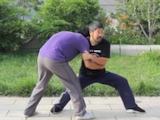- Reference points: counting is to establish a standard for us to be able to teach and communicate
- Direction: must not lose the aim. Don’t lose the 45 degree facing when practicing the foundational exercises
- Positive circle 3 count: 1. in elbow; back shoulder to forward foot is the axis. 2. rotate waist don’t involve spine and don’t lose previous axis. 3. push foot, aim at hand. There is a split in the middle. Again don’t lose previous two axes
- Feels like your body is splitting apart
- Five bows in body are in five directions
- Double heavy – two parts next to each other are “joined” in movement. The error is when they are stuck together
- It’s important to stick to the system to learn. Don’t overthink the principle just follow the method and it will lead to the principle
- Changing the pivot changes the size
- 3 lines in positive circle; keep each of them without losing any and add the others
- The dantien and knees (the dang) – being able to switch the pivot between the three points
- 覆蓋對吞 apply (gauze), to cover / aim / swallow. Method of fighting – to swallow and spit
- Lancayi and other stepping moves – front shoulder and kua can’t move forward with foot
- 360 turn has to have axis down shoulder
- Rubber cord example: Learn how to not move the root, then how to not move the tip, then eventually how to not move a point in the center to match
- Don’t move the hand!
Day 2 notes
- Revolution vs rotation. They happen in different dimensions. Rotation inside structure / revolution outside structure. Hard to understand because in one dimension, one part is not moving but in another dimension it is moving. Movement is relative
- 5 points outside the body create the external structure; inside one dot
- Real movements are not linear; there is an allowable amount of give but the bend is aimed by the dot
- 合力 he li (combined force) is invisible but more sophisticated.
- Hooks and anchors- relationships between different points. Have to be able to see the points and how they relate by observing Master Chen
- Must pay attention to minute details in the action. Don’t get it because you aren’t listening and in your own dimension or have deviated from the original lesson
- Arch has to be empty inside. Gave an example using his phone tripod with a stick interrupting the middle of the tripod to make it unsteady. The feet have to have the arch
- Special positions / weak points qiao. You want it to be in your dantien. Guan (fortress) guard the strategic spots. 玄? Xuan (mysterious) sort of like timing and positioning – being in the right place at the right time?
- Get the feeling of making the large movement. Did an exercise to make the line with the front kua as in the second step of positive circle, except with a large movement disregarding other restriction
- First, when joint is not moving, next joint can move. The not moving joint can transfer the movement to other joints.
- Two ends of my thigh have to rotate in different directions
- The front has to be dead or else the aim changes
- We talked about resonance and Master Chen described how he applies it to measure and apply power. From a physics perspective resonance seems to relate size with efficiency
- Real learning happens when you don’t understand and discover it after being able to do it – train the system and you will find the concepts when you become capable
- Withdrawing elbow have to make sure not to add with shoulder and add the heel



{ 4 comments… read them below or add one }
Hi, can someone help me to clarify something about the positive circle?
Regarding the 3 count Edward mentioned : “1. in elbow; back shoulder to forward foot is the axis”
I always thougt the axis was from front shoulder to forward foot, installing a wall against incoming force…
Positive Circle is a tool that can be used to train different aspects of the body. By forming different axes, we focus on different aspects. From Edward’s description, it seems like it’s about creating an X in the body in this case. I’ll wait for Edward’s further elaboration as well.
Thx Kelvin, that made sense.
I believe that what Kelvin said is the case. If I recall correctly, I was making a mistake in moving my rear shoulder while withdrawing the elbow, and shifu corrected me, telling me to make sure that I had an axis from the rear shoulder to front foot.